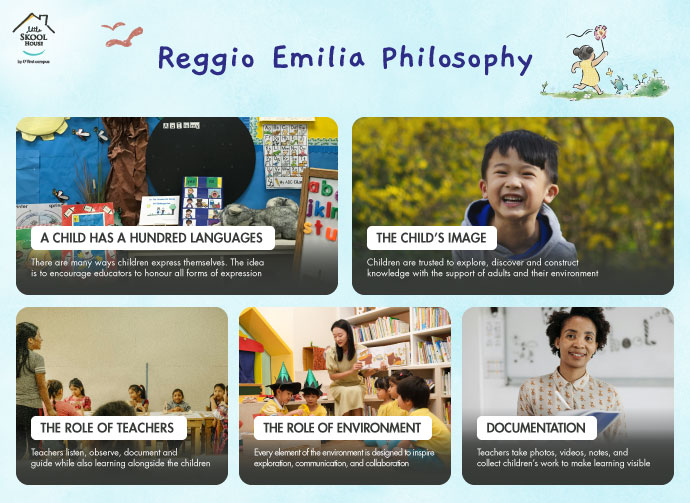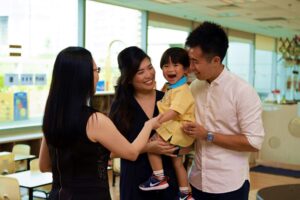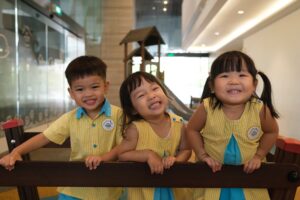BACK
The Reggio Emilia approach is often praised for its child-centric philosophy that nurtures creativity, autonomy and a lifelong love for learning. But what is it really?
More than just an educational method, Reggio Emilia is a deeply rooted philosophy that celebrates the child as capable, curious, and full of potential.
Whether you’re a parent exploring early education options or an educator interested in child development, here’s everything you need to know about the Reggio Emilia approach.
How did the Reggio Emilia approach originate?
The Reggio Emilia approach originated after World War II in the town of Reggio Emilia in northern Italy. It was developed by educator Loris Malaguzzi in collaboration with local parents who were eager to build a new, more inclusive society.
Their goal was to create a system of education that empowered children to become critical thinkers and responsible citizens. What emerged was a philosophy that sees the child not as an empty vessel to be filled with knowledge but as an active participant in their own learning.
What is the Reggio Emilia philosophy?
At the heart of the Reggio Emilia philosophy is a profound respect for the child. It views each child as strong, competent, and full of wonder. Learning is not dictated but rather co-constructed through experiences, exploration, and meaningful relationships.

A Child Has A Hundred Languages
A central concept of the Reggio Emilia approach is that a child has “a hundred languages” — a metaphor for the many ways children express themselves, such as through drawing, music, dance, sculpture, storytelling and more.
This idea encourages educators to honour all forms of expression, not just verbal or written language, and to provide children with the tools and time to explore them.
The Child’s Image
Reggio educators believe that children are born with rights and potential. They are seen as capable, resilient, and rich in imagination.
Rather than being seen as passive recipients of information, children are trusted to explore, discover and construct knowledge with the support of adults and their environment.
The Role of Teachers
In Reggio Emilia, teachers are not mere instructors but co-learners and collaborators. They listen, observe, document and guide while also learning alongside the children.
Teachers design meaningful experiences based on the child’s interests and maintain a flexible curriculum that evolves.
The Role of Environment
The learning environment in a Reggio classroom is often called the “third teacher” — after the parents and educators. Every element of the space is intentionally designed to inspire exploration, communication, and collaboration.
Natural light, open-ended materials, mirrors, and displays of children’s work all contribute to an atmosphere that respects and celebrates children’s ideas and efforts.
Documentation
Careful documentation is a cornerstone of the Reggio Emilia approach. Teachers take photos, videos, notes, and collect children’s work to make learning visible.
This documentation is not just for assessment but serves as a tool for reflection, dialogue, and celebration of progress — for children, parents, and educators alike.
What are the core values of the Reggio Emilia approach?
Reggio Emilia is not a prescribed curriculum but a guiding philosophy shaped by several fundamental values.
Children Actively Participate in Learning
Children are naturally curious and capable of driving their own learning. Educators observe and extend children’s inquiries, offering resources and opportunities that align with their interests and questions.
Environment Plays a Significant Part
Spaces are designed to invite exploration and dialogue. Classrooms are carefully arranged to foster independence and collaboration, reflecting the belief that surroundings can influence how children feel and interact.
A Collaborative Teachers-Parents-Children Relationship
Family involvement is essential. Parents are viewed as partners in education and are actively encouraged to engage with teachers and participate in classroom life. This strong partnership enriches the learning experience and reinforces the child’s sense of belonging.
Learn How to Collaborate and Communicate in Their Communities
Reggio Emilia classrooms prioritise relationships. Children are taught to work together, share ideas, negotiate, and support each other. These skills extend beyond the classroom, preparing children for their roles in broader society.
Give Children Practical Experiences Based on Creativity
Hands-on experiences are at the core of Reggio Emilia’s learning. Art, play, science, and storytelling all serve as vehicles for exploration and discovery. Creativity is not an isolated subject but a mindset that underpins all learning.
Challenges of the Reggio Emilia Approach
1. Resources
Reggio Emilia classrooms require highly trained educators, extensive documentation, and carefully curated environments, which can make the model a costly and challenging approach to preschool education.
2. Standardisation
Since the approach is philosophy-driven rather than curriculum-based, implementation can vary widely across schools, yielding output with varying levels of quality.
3. Academic Structure
While it fosters creativity and social-emotional learning, Reggio Emilia may not place as much emphasis on early academic foundations like phonics, numeracy, or structured literacy development.
4. Teacher’s Skill
The quality of the learning experience is deeply tied to the educator’s ability to observe, document, and respond to children’s interests. In less experienced hands, the approach may lack depth.
5. Recognition
Compared to Montessori or more standardised early childhood models, Reggio Emilia is less widely understood, which may impact parent buy-in or continuity of education.
The Little Skool House: A Well-Rounded Approach
While the Reggio Emilia approach began in Italy, its influence has spread globally, including to Singapore, where parents have a growing interest in holistic and inquiry-based education.
For parents who appreciate the emphasis on holistic development but also want a more structured foundation in academic readiness, Little Skool House offers a compelling alternative.
Backed by a bilingual curriculum and a strong focus on early literacy and numeracy, the programme blends play-based learning with intentional teaching practices. Its emphasis on language acquisition, combined with culturally rooted values and research-informed pedagogy, provides both breadth and depth in early childhood education.
For families who value both creative exploration and academic preparation, Little Skool House may strike that ideal middle ground.
Little Skool House is one of the premier premium preschools in Singapore, offering a research-informed curriculum inspired by similar philosophies, tailored specifically for Singaporean children.
With a strong focus on language development, creativity, and child-led learning, Little Skool House nurtures confident communicators and curious thinkers.
Their environments are thoughtfully designed to reflect respect for children’s ideas while experienced educators work closely with families to support each child’s journey.
The preschool curriculum integrates play, storytelling, culture, and discovery — all while grounding learning in real-world experiences.



